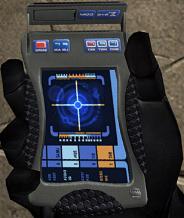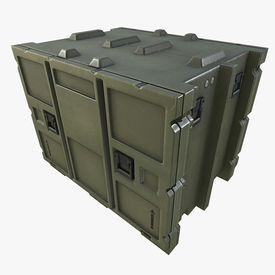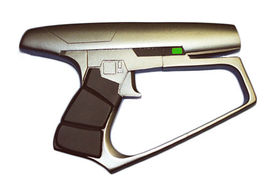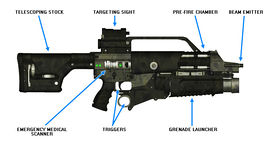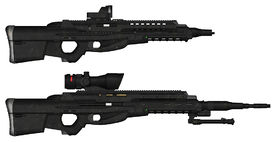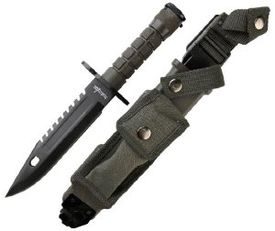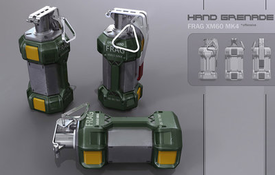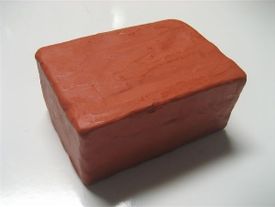Victory Marines/Shadow's Equipment
| USS Victory | ||
|---|---|---|
 NPC STATUS VESSEL | ||
| ||
Marine Weapons and Equipment Regulations
Non-combat
A Starfleet Marine assigned to a duty post will wear their:
- Standard Duty Uniform
- Marine Combat Knife (concealed)
Combat
When involved in combat operations, a Marine will wear their:
- Standard Duty Uniform
- Body Armor
- Helmet
- ISARAS
- Combat Tricorder
- Marine Combat Knife
- Marine Aquila
- Kits/Extra Weapons
Marine Equipment Descriptions
ISARAS
The Integrated Search and Rescue Armour System (ISARAS) is a modular armoured vest system based on the Crye and CIRAS systems of 21st century Earth, designed specifically for the varied duty requirements of the SAR Team. The vest itself provides superior protection from physical attack as well as substantial protection from most energy-based weapons fire.
The ISARAS can be fitted with numerous pouches and clips and customized to the individual wearer and their role on the SAR Team. For example, an engineer may have -- in addition to the phaser holster standard on all configurations -- a tricorder pouch and various tool and equipment pouches/clips, while a medical officer would carry advanced medkits, hyposprays, etc. A marine participant may have the majority of their ISARAS dedicated to carrying weaponry and explosives, depending on the role the individual has been asked to fill.
Helmet & Body Armour
The Helmet is constructed with a hardened ballistic plastic, the CADM (Crystalline Ablative Dispersal Matrix) Ballistic Helmet is fitted with a retractable visor for a full seal. The helmet contains an advanced multi-function communications system. Operated by pupil tracking and a verbal shorthand, the Ballistic Helmet allows a Marine hands-free operation of the unit while concentrating on fighting and other attention-intensive tasks.
The helmet's multi-function communications system can send the Marine's coordinates to units nearby, perform mapping and navigation functions, and project command and mission data on the visor. It also includes a helmet-to-helmet infrared communications link, allowing discrete, short distance communications between individual Marines while lessening the chances of interception, communications signal encryption, as well incorporating standard combadge traffic.
The ballistic helmet's visor also operates as a data screen for the user's Combat Tricorder and other linked or integrated systems. The visor's systems open programming structure allows it to accept multiple signals and upgrades in the field. It also features a three hundred sixty degrees proximity and target/threat tracking display, low light vision enhancement with rapid polarization, and audio enhancement/suppression to prevent disorientation. Sensory enhancements and protections can be modified to accommodate different species' sensory requirements; although after a certain point of acuity, the helmet is configured to allow a Marine's senses to work without the helmet's interference.
Each Marine's helmet is equipped and programmed to assist them in tasks specific to their position and MOS such as target designation, range finding, and chemical analysis. Officers and NCOs get units with more processing power and a broader range of capabilities and command functions, including signal interception, analytical functions, and troop status readouts.
The helmet can be modified to fit the ergonomic, mission, and, to a limited extent, the aesthetic needs of the individual Marine.
Personal protection for a Marine in combat operations is essential. Marine Body Armor is designed to provide a balance between protection and weight. The body armor is separated into upper body and lower body protective gear. The Marine Body Armor consists of the same CADM (Crystalline Ablative Dispersal Matrix) that is utilized in the Marine Ballistic Helmet. The protective vest contains remote biomonitors, which measure the wearer’s health, and a personal transport inhibitor designed to prevent enemies from using transporters against Marine units.
Hazard Team Duty Uniform
In certain circumstances, wearing a standard Starfleet duty uniform is not practical. In such instances, Hazard Teams can choose to wear a specially-designed duty uniform known as the HDU. The HDU is made of a lightweight, but extraordinarily durable synthetic fibre that is highly resistant to heat, cold and tearing. The HDU is also a temperature-regulating fabric, allowing its wearing to better adapt to extreme temperatures and/or rapid change in temperature.
Combat Tri-Corder
The combat tricorder is a specialized tricorder carried by Starfleet Marines. Along with its basic tricorder functions, the combat tricorder is programmed with strategic and tactical information and countermeasures. The combat tricorder links with the Ballistic Helmet for combat operations.
SAR Gear Box (3 Onboard)
- Tricorders and PADDs – 4x medical and 4x standard.
- 10x First aid kits with equipment such as dermal regenerators, bone knitters, painkillers and other drugs and equipment needed to adequately treat patients at the scene.
- 12x Flashlights, 10x power packs, 4x grappling gear, 6x heavy duty wiring and ropes, 12x survival packs (and rations), 2x heavy cutting gear, 4x harnesses, 6x underwater breathing apparatus, 10x spades and 10x pickaxes, flares, 8x pattern enhancers.
Hazard Gear Box (3 Onboard)
- Tricorders – Combat and standard.
- 12x Aquilas, 4x Type 33 CQC, 2x Engineering Kits, 2x Science Kits, 2x Medical Kits, 4x Each Grenade and Combat Shields.
- 12x Body Armour, 12x Helmets and 12x ISARAS
Command Center Box (1 Onboard)
- 1x Command Unit comparison of mobile sensor unit, minilab, small armoury, 2x computer station with multi use and enhanced comm array.
Marine Weapons Descriptions
Weapon Settings
|
Aquila (30 Onboard)
An updated model of the standard Type -2 that was used throughout the early 24th Century, the Aquila pattern was designed for use by the Federation Marine Corps, Starfleet Hazard teams, and for more robust away missions. Built on the more sturdy ancient Terran design for firearms, the Aquila was designed to be more durable and further in line with the primary weapons often used by the marines. Along with these design improvements the Starfleet Corps of Engineers simplified the power scale and restructured the emitter to fire phaser pellets instead of a concentrated phaser beam. This change removed the Aquila from a ‘tool’ category and grounded it firmly as a weapon. Instead of a scaling power level from one to sixteen, which was used primarily to credit the original models as a cutting tool, the Aquila has five settings. Light Stun, Heavy Stun, Disruption, Lethal (Kill), and Disintegrate. The final setting has a limited range and spends the weapons power supply quickly. A blue digital readout on the right and left side of the weapon displays the remaining charge and current setting.
Beam Intensity Settings: 1, 3, 7, 9 & 12
Type 33 CQC (10 Onboard)
The Type 33 Close Quarters Combat Phaser Rifle is the newest addition to the Starfleet armoury. Production began in early 2388 in response to problems and concerns raised by Starfleet officers participating in the retaking of space station Deep Space 17 during the Second Battle of Eratis. The Type 33 CQC's compact design is intended to make operating in confined spaces, such as the corridors and jeffries tubes of DS17, far easier. Total length of the Type 33 CQC is 688mm (27.08 inches) and its weight is 2.54 kg (5.6 lbs).
The type 33 is the primary rifle of choice for standard SAR operations going forward, due to their small, lightweight design.
Beam Intensity Settings: 1 to 7
Type 28 (10 Onboard)
Initially designed as a special operations rifle for the Starfleet Marines, the Type 28 was quickly adopted as a useful mid-level workhorse rifle for Search and Rescue. Though not as compact as the Type 33, the 28's modular nature makes it a very useful tool -- the targeting sight can be swapped out for several different types of sight and the folding fore-grip can also be removed and replaced with a flashlight, scanner or one of several other types of tool.
Beam Intensity Settings: 1 to 8
Type 204 SOSAR (5 Onboard)
The Type 204 SOSAR (Special Operations - Search And Rescue) has the distinction of being the only phaser designed specifically for Starfleet Search and Rescue. Based loosely on the Type 200 rifle -- which is still used by some marine contingents -- the 204 SOSAR includes many improvements, including an adjustable telescoping stock, a rail system to allow the attachment of various scanning and infrared tools, an extremely durable plasteel body and the standard attachment of a grenade launcher (primarily for using "flash-bang" grenades). The SOSAR is clearly a rifle used in more hostile situations, where it is known ahead of time that a SAR Team will face serious opposition to their goals from well-armed adversaries.
Pulse Intensity Settings: 3 to 10, 13 & 16
Grenades: Flash-bang (Standard) Explosive ( Timed & Contact) Gases (Various) Thermal
Type 32 (5 Onboard) and 32A OSR (5 Onboard)
A rather larger rifle, the Type 32's base design was adapted to become the Type 33 CQC. A workhorse rifle, the 32 is still used in many combat situations, primarily by Starfleet Marines, but also in some situations by Starfleet Security. Many prefer it's more ergonomic design to that of the SOSAR. It's length makes the 32 generally ill-suited to SAR operations, but it's Operational Support Rifle variant -- the Type 32A OSR -- has become standard equipment in any Search and Rescue department. Essentially a sniper rifle, the 32A goes by the much less militaristic sounding name of "Operational Support Rifle." The 32A OSR shares the same body as the Type 32, with a longer barrel, more advanced and higher quality targeting sight and a folding bipod. The purpose of the OSR is to provide support for evacuations and protection for SAR Team members performing their duties in hostile environments.
Pulse Intensity Settings (32): 1 to 10
Pulse Intensity Settings(32A): 3 to 16
TR-116 Rifle (Restricted to Marines.) (2 Onboard)
The TR-116 Rifle is a hand-held rifle that delivers a lethal projectile for use in dampening fields or radiogenic environments where conventional energy weapons are useless. The rifle fires a chemically propelled titanium bullet. The rifle can be modified to use a micro-transporter to beam the projectile into a nearby room at lethal velocity at the time the trigger is pulled. Targeting for the rifle is made through the Combat Tricorder and/or Ballistic Helmet visor under these circumstances.
Due to the power expenditure and the rare use of this weapon, only four TR-116 Rifles are stored in each Marine armory.
Beam Intensity Settings: 7 & 8
Marine Combat Knife (30 Onboard)
The Marine Combat Knife is a survival and combat knife. It has a single edged twelve inch durasteel blade. The standard issue knife has a matte black finish to avoid reflection and to decrease the chances of detection.
The handle contains a small laser torch and a wire saw that can assist a Marine during wilderness survival.
Statistical Information: Length: Blade - 12 inches / Overall - 17.25 inches Weight: 3 pounds
Maintenance: Minimal maintenance is required since the blade maintains its sharpness and avoids rust over long term use.
Riot Gas Grenade
O-chlorobenzylidene malononitrile also know as Riot Gas (chemical formula: C10H5ClN2), a cyano carbon, is the defining component of a tear gas commonly referred to as CS gas.
Exposure causes a burning sensation and tearing of the eyes to the extent that the subject cannot keep their eyes open, and a burning irritation of the nose, mouth and throat mucous membranes causing profuse coughing, mucous nasal discharge, disorientation, and difficulty breathing, partially incapacitating the subject.
Frag Grenade
A fragmentation grenade (commonly known as frag or frag grenade) is an anti-personnel weapon that is designed to disperse small projectiles or fragments on detonation.
Stun Grenade
A stun grenade, also known as a flash grenade or flashbang, is a non-lethal explosive device used to temporarily disorient an enemy's senses. It is designed to produce a blinding flash of light and intensely loud noise "bang" of greater than 170 decibels (dB) without causing permanent injury.
EMP Grenade
An electromagnetic pulse (EMP), also sometimes called a transient electromagnetic disturbance, is a short burst of electromagnetic energy. Such a pulse may occur in the form of a radiated, electric or magnetic field or conducted electrical current depending on the source, and may be natural or man-made. The term "electromagnetic pulse" is commonly abbreviated to the initialism EMP (which is pronounced by saying the letters separately, "E-M-P").
Incendiary Acid Grenades
This grenade explodes in an acidic cloud, covering a 2 meter radius from the center location. The grenade has two modes one is release of the acid cloud that will burn flesh and damage certain alloys. The second function is after the Acid gas is depleted the grenade will spark causing the Acid cloud to explode into flames.
Cluster Grenade
This is a cluster grenade that ejects explosive bomblets that are designed to kill personnel and destroy vehicles.
Micro Mines
A micro mine is an explosive device concealed under or on the ground and designed to destroy or disable enemy targets, ranging from combatants to vehicles, as they pass over or near it. Such a device is typically detonated automatically by way of pressure when a target steps on it or drives over it, though other detonation mechanisms are also sometimes used. A micro mine may cause damage by direct blast effect, by fragments that are thrown by the blast, or by both.
Explosive Compound
An explosive compound, also called an explosive, is a reactive substance that contains a great amount of potential energy that can produce an explosion if released suddenly, usually accompanied by the production of light, heat, sound, and pressure.




